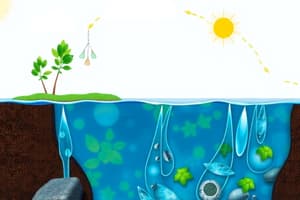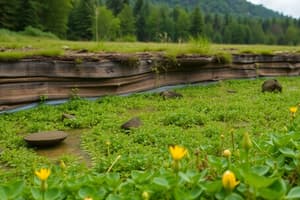Podcast
Questions and Answers
What is the significance of water being a universal solvent in biogeochemical cycles?
What is the significance of water being a universal solvent in biogeochemical cycles?
- It allows gases to dissolve more easily in water bodies.
- It helps in the transport of nutrients and waste products within organisms. (correct)
- It prevents the evaporation of essential nutrients from soil.
- It provides structural support to plant cells in the ecosystem.
Which statement best describes the process of nutrient cycling in the context of biogeochemical cycles?
Which statement best describes the process of nutrient cycling in the context of biogeochemical cycles?
- Nutrients are lost from the ecosystem during their cycling phase.
- Nutrients transition between several reservoirs and are reused by organisms. (correct)
- Nutrients are permanently stored within the biosphere without movement.
- Nutrients only move through the abiotic components of the ecosystem.
What characterizes a slow nutrient cycle in biogeochemical terms?
What characterizes a slow nutrient cycle in biogeochemical terms?
- Nutrients are rapidly exchanged among living organisms.
- The cycle results in immediate availability for organisms.
- Substances remain in reservoirs for extended periods of time. (correct)
- Nutrients only cycle through water bodies.
How does water contribute to the process of photosynthesis in photoautotrophs?
How does water contribute to the process of photosynthesis in photoautotrophs?
Why is hydrogen bonding in water significant for its role in biogeochemical cycles?
Why is hydrogen bonding in water significant for its role in biogeochemical cycles?
Which of the following elements is most directly linked to the cycling of carbon and oxygen in biogeochemical processes?
Which of the following elements is most directly linked to the cycling of carbon and oxygen in biogeochemical processes?
What role does water play in the biochemical reactions occurring within living cells?
What role does water play in the biochemical reactions occurring within living cells?
In what way do the physical properties of water enhance nutrient cycling within ecosystems?
In what way do the physical properties of water enhance nutrient cycling within ecosystems?
What is the primary role of carbon sinks in the carbon cycle?
What is the primary role of carbon sinks in the carbon cycle?
Which statement correctly describes the nitrogen cycle's processes?
Which statement correctly describes the nitrogen cycle's processes?
In what way does phosphorus cycling differ from carbon cycling?
In what way does phosphorus cycling differ from carbon cycling?
What consequence does deforestation have on the carbon cycle?
What consequence does deforestation have on the carbon cycle?
Which process contributes to the slow cycling of carbon?
Which process contributes to the slow cycling of carbon?
What is the significance of stromatolites in understanding biospheric evolution?
What is the significance of stromatolites in understanding biospheric evolution?
How do human activities disrupt biospheric equilibrium?
How do human activities disrupt biospheric equilibrium?
What is a primary process by which nitrogen gas becomes usable for plants?
What is a primary process by which nitrogen gas becomes usable for plants?
Which of the following is a rapid cycling process in the phosphorus cycle?
Which of the following is a rapid cycling process in the phosphorus cycle?
How does cellular respiration impact atmospheric composition?
How does cellular respiration impact atmospheric composition?
What leads to increased atmospheric CO2 levels during fossil fuel combustion?
What leads to increased atmospheric CO2 levels during fossil fuel combustion?
Which process is involved in the transformation of ammonium ions to nitrates?
Which process is involved in the transformation of ammonium ions to nitrates?
What is the primary driver of biological productivity in ecosystems?
What is the primary driver of biological productivity in ecosystems?
Flashcards
Biogeochemical Cycle
Biogeochemical Cycle
The movement of chemical elements and compounds through the abiotic and biotic components of an ecosystem.
Cycling of Matter
Cycling of Matter
The movement of substances through living (biotic) and non-living (abiotic) parts of an ecosystem.
Nutrient Reservoirs
Nutrient Reservoirs
Places where substances are temporarily stored during a biogeochemical cycle, such as organisms, air, soil, and water.
Short-term Nutrient Cycling
Short-term Nutrient Cycling
Signup and view all the flashcards
Long-term Nutrient Cycling
Long-term Nutrient Cycling
Signup and view all the flashcards
Water's Role in Photosynthesis
Water's Role in Photosynthesis
Signup and view all the flashcards
Water Loss in Organisms
Water Loss in Organisms
Signup and view all the flashcards
Water's Polarity
Water's Polarity
Signup and view all the flashcards
Nitrogen Fixation
Nitrogen Fixation
Signup and view all the flashcards
Ammonification
Ammonification
Signup and view all the flashcards
Nitrification
Nitrification
Signup and view all the flashcards
Denitrification
Denitrification
Signup and view all the flashcards
Carbon Sinks
Carbon Sinks
Signup and view all the flashcards
Carbon Sources
Carbon Sources
Signup and view all the flashcards
Biological Productivity
Biological Productivity
Signup and view all the flashcards
Stromatolites
Stromatolites
Signup and view all the flashcards
Biosphere Equilibrium
Biosphere Equilibrium
Signup and view all the flashcards
Photosynthesis
Photosynthesis
Signup and view all the flashcards
Cellular Respiration
Cellular Respiration
Signup and view all the flashcards
Biogeochemical Cycling
Biogeochemical Cycling
Signup and view all the flashcards
Carbon-Oxygen Cycle
Carbon-Oxygen Cycle
Signup and view all the flashcards
Why is Nitrogen Essential?
Why is Nitrogen Essential?
Signup and view all the flashcards
Why is Phosphorus Essential?
Why is Phosphorus Essential?
Signup and view all the flashcards
Study Notes
Biogeochemical Cycles
- A biogeochemical cycle is the continuous movement of substances between the biotic (living) and abiotic (non-living) components of an ecosystem.
- This movement allows organisms to obtain essential nutrients.
- Substances are temporarily stored in reservoirs like organisms, air, soil, and water during the cycle.
- Nutrient cycling describes the relatively quick cycling of substances between reservoirs (e.g., carbon from producer to consumer to decomposer).
- Nutrient sequestration refers to the long-term storage of substances, making them unavailable to organisms for a substantial period (e.g., fossil fuels, peat, rocks).
Role of Water in Biogeochemical Cycles
- Water is crucial for all organisms, enabling nutrient transport and biochemical reactions within cells.
- Photoautotrophs (plants) need water for photosynthesis.
- Organisms need to replenish water lost through excretion, respiration, and transpiration.
- Water's polarity and hydrogen bonding give it unique properties crucial for biogeochemical cycles.
The Carbon and Oxygen Cycle
- Carbon and oxygen cycles are interconnected through photosynthesis and respiration.
- Rapid carbon cycling involves processes like cellular respiration, the absorption and release of CO2 by producers, and the cycling between the living organisms.
- Slow carbon cycling involves the formation of fossil fuels, sediments, and weathering of limestone.
- Carbon sinks absorb more carbon than they release (e.g., oceans), while carbon sources release more carbon than they absorb (e.g., burning fossil fuels).
- Deforestation and rising ocean temperatures increase atmospheric CO2.
Nitrogen Cycle
- Nitrogen is essential for protein and nucleic acid synthesis.
- Nitrogen gas (N2) is unusable by most organisms.
- Plants often obtain nitrogen as ammonia (NH4+) or nitrites/nitrates.
- Animals obtain nitrogen by consuming plants or other animals.
- Nitrogen fixation is where bacteria convert N2 into ammonium (NH4+).
- Ammonification is the breakdown of organic matter into ammonia/ammonium by decomposers.
- Nitrification involves bacteria converting ammonia to nitrates (NO3−).
- Denitrification involves converting nitrates back to N2 by bacteria.
Phosphorus Cycle
- Phosphorus is essential for DNA, RNA, and ATP.
- Producers utilize phosphate dissolved in water.
- Consumers obtain it by consuming plants/other animals.
- Rapid phosphorus cycling involves absorption by producers and transfer through food chains.
- Slow phosphorus cycling involves the formation and release of phosphorus minerals.
Biosphere in Balance
- Biological productivity is the rate at which producers store energy.
- Productivity varies based on light/heat, nutrients, and moisture.
- High productivity is commonly found in areas with abundant sunlight and moisture.
- Stromatolites are layered sedimentary rocks formed in ancient oceans showing a past high oxygen level, proving change in atmospheric composition.
- The biosphere dynamically maintains equilibrium but may be disrupted by human activities.
Studying That Suits You
Use AI to generate personalized quizzes and flashcards to suit your learning preferences.




